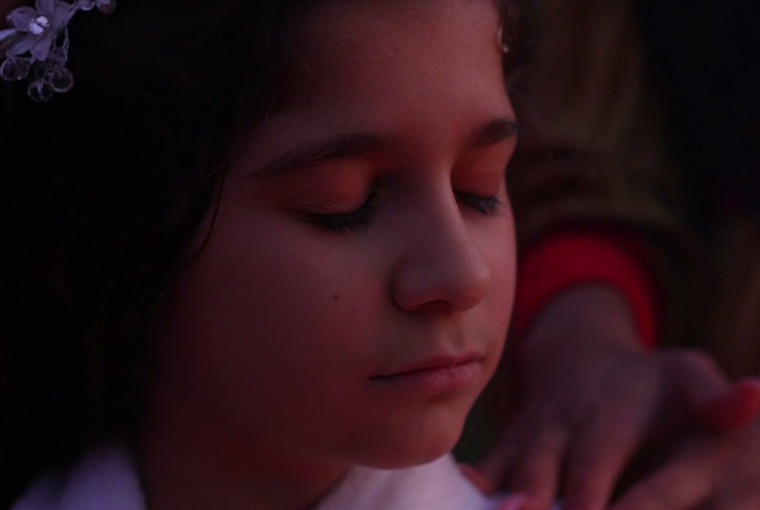From Transgenerational Trauma to Roma Futurism
Mihaela Drăgan’s The Future is a Safe Place Hidden in my Braids (2021)
Vol. 134 (April 2023) by Anna Doyle
Since I am a woman whether or not
You are against me
I will braid my hair
Even
In the season of rain.
– Audre Lorde, “Dahomey”, 1978.1
Poised between anticipation and emancipation, Mihaela Drăgan’s The Future is a Safe Place Hidden in My Braids, presented at the 2021 Bucharest International Experimental Film Festival, interlaces the art of fortune-telling with the hope of salvation. In the film, occult Romani rituals become synonymous with women’s liberation. Divided into three parts, it pictures Roma witches practicing an invented ritual, one that will exorcise slavery, the Holocaust, racist stereotypes, and the general oppression of the Roma. Mihaela Drăgan is a playwright who founded the first Roma Theater in Romania, the Giuvlipen Theater Company. The Future is a Safe Place is her debut feature. Articulating women’s issues and Roma rights, the film positions itself in the intersectional feminist movement. Although Roma people have a great importance in Romanian society and culture, they have had to deal with the pain of cumulative trauma across generations due to their systemic marginalization. The film features one of the most famous witches of Romania and Europe, Mihaela Minca, whose mother-in-law, Bratara Buzea, was herself a witch recognized by many as rarely powerful. Many laws against witchcraft have been implemented throughout Romanian history, and politicians often fear its power – Bratara Buzea was jailed under Nicola Ceaușescu’s regime when it banned witchcraft. Today, witchcraft is very much alive in Romania as there are hundreds of witches in the country, and supposedly one in ten Romanians visits a witch to release them from evil spells or to predict the future. A joyful and colorful image of Roma culture is displayed in the film, overshadowed though it is by the grim history of Romani discrimination. In The Future is a Safe Place, aesthetics and politics are brought together in an effort to debunk stereotypes.
The Roma are one of the largest Romanian minorities. From more than six centuries of slavery to the forced assimilation in Romanian society to the persecution of Europe’s Roma by the Nazis – who murdered between 250,000 and 500,000 Roma during the Holocaust – through to contemporary discrimination in public life, the Roma have been victims of some of the worst racial injustices in the history of mankind. Roma slavery remains taboo in modern Romania and has been erased from most history books, whereas the first monument to Romani Holocaust victims was only erected in 2015. Nowadays, Roma people in Romania are still rejected with prejudice and are considered to be the most vulnerable ethnic group in contemporary Romania. Mainstream Romanian cinema conveys these ideas of victimhood, as well as picturing Roma women as exotic, or, with patronizing eyes, as victims to be saved by a white person.
In an attempt to defy these stereotypes, Mihaela Drăgan has researched the cultural diversity of Roma rituals and collaborated with Roma witches. Based on this collaborative exploration, she invented a new ritual – one that casts an evil spell on the hatred of Romani people. This new ritual is not so much an ethnographic fact that the documentary simply captures, nor is it an attempt to “invent a tradition” for nationalist purposes. Rather, it appears as an experimental cinematic tool to exorcise trauma and help women self-emancipate. The images show the different steps of the ritual, from the braiding of the hair to the witches’ cauldron and their dances on the beach, from the candle ceremony to the flower ceremony. The image of the Roma moves away from the stereotypical myth of Roma people being poor, in need, and disrespectful. Rather Roma women are pictured as playful and opulent, with the three Roma witches sitting on big golden thrones. They are wearing gold and silver jewelry, have their nails done and wear headdresses decorated with coins while fresh flowers and ornaments surround them that are all considered to be tokens of good fortune. Furthermore, rituals are not only seen as a reflection of an occult belief of Roma women but as also being an aesthetic means to express themselves and articulate political issues. As experimental filmmaker Maya Deren said, “ritual is art; and even historically, all art derives from ritual”.2 According to Deren, ritualistic forms of expression unlock powers of abstraction:3
The ritualistic form deals above all with the human being not as the source of dramatic action, but rather as a somewhat depersonalized element in a dramatic whole; the purpose of such depersonalization is not the destruction of the individual, on the contrary, it expands him beyond his personal dimension and frees him from specializations and personality limitations. The function of the rite is not only to abstract the individual, to personalize him, but to subject him to a metamorphic power.
In the film, the metamorphic power alluded to by Deren materializes in the transformation of the collective’s traumatic past into a regenerated vision of the future. Individual destinies do not matter for the drama of the film as much as the collective voice does. Technology plays an important role in this transformation, as the voiceover sings: “Seeds that will blossom in the techno-witches. The power of our magic. Multiply through the use of technology.” Mihaela Drăgan has coined the concept of “Roma-futurism”, that is the idea that the Roma community must project visions of the future rather than holding on to the traumatic past. And this is made possible by technology – indeed many witches perform rituals and fortune-telling through online platforms and resort to tech tools in their art. In a cyber-feminist move, the Internet has allowed Romania’s witch community to upload their ancient practices on the web.
Roma culture has a rich oral tradition, which is emphasized in the film’s poetic and incantatory voiceover. The voice does not spread anger but a magical power which breathes a poetic spell. Language is not primarily presented as a rigidly organized system of rules and calculi, but as a performative means of expression. It is through language, technology, and the witches’ specific powers that Romani women exercise control over peoples’ destinies and thus reach a degree of self-empowerment.
Cinema appears as a form of resistance and a tool to debunk the myth of the Roma victim. The reference to “a safe place” in the title refers to the idea of “safe spaces”, that is, political places specifically designed for marginalized voices to safely express their traumatic experiences. In the title of the film, this safe place is localized in braids because braiding hair is an ancient women’s practice, and also because hair is a very important element of Romani fortune telling – for example, Roma women must hide their hair when they are fortune telling. Braiding hair is also seen as a form of intergenerational solidarity between women. Lineage between women is indeed very important for witches, for as Mihaela Drăgan points out, “witches are the only matrilineal tribe of Roma people. All others transmit inheritance through male lineage”.
Experimental witchcraft, healing rituals, and imagined rites show the force, will, and imagination that are needed to fight against injustices. Witchcraft is seen as a “mission” that originates in “roots”. Finally, witchcraft seems to not only be a force against the patriarchy and political oppression but also against capitalism as a whole. The practices of witchcraft are another kind of intelligence that the capitalist ideology of progress and scientific positivism has exterminated and expropriated. In an interview we did with her, Drăgan quotes Sivilia Federeci’s work Caliban and the Witch: Women, the Body and Primitive Accumulation4 as an influence. The book shows the concomitance of witch trials with the birth of capitalism:
the body is transformed into a machine-tool and the submission of women to the reproduction of labour-power. It required above all the destruction of women’s power. The destruction of women’s power, [which] in Europe and America was achieved by the extermination of ‘witches’.
It should be noted that historically witches in Romanian society had a role that was somewhat less precarious. Though marginalized and vulnerable to abuse and violence, they were not systematically trialed to be killed, as was the case in other countries.5
The witches in Mihaela Drăgan’s debut feature are joyful and strong, linked to both technology and tradition, they therefore seem to disturb the established order with their magic and resist not only transgenerational anti-Roma stigma but also the entire capitalist and rational thought-system at work in our history, which has tried to erase the empowering and feminine practice of witchcraft. The film succeeds in aesthetically projecting a future so as to find peace from the turmoil of the past, and positively pushes the spectator to reconsider their own thought-system, practices and stereotypes.
References
- 1.Lorde, Audre. “Dahomey’’. In: Black Unicorn. W.W Norton, 1978; 10.
- 2.Deren, Maya. Une anagramme d’idées sur l’art, la forme et le cinéma, 1948. In: Ecrits sur l’art et le cinéma, trad. Julie Beaulieu and Eric Alloi. Paris Expérimental, 2004; 38.
- 3.Ibid.
- 4.Federeci, Silvia. Caliban and the Witch: Women, the Body and Primitive Accumulation. Autonomedia, 2004.
- 5.Luca, Ana Maria. The Future Belongs to Witches. https://www.areweeurope.com/stories/romania-witchcraft-ana-maria-luca/ [Accessed on 19 June 2023].




Leave a Comment